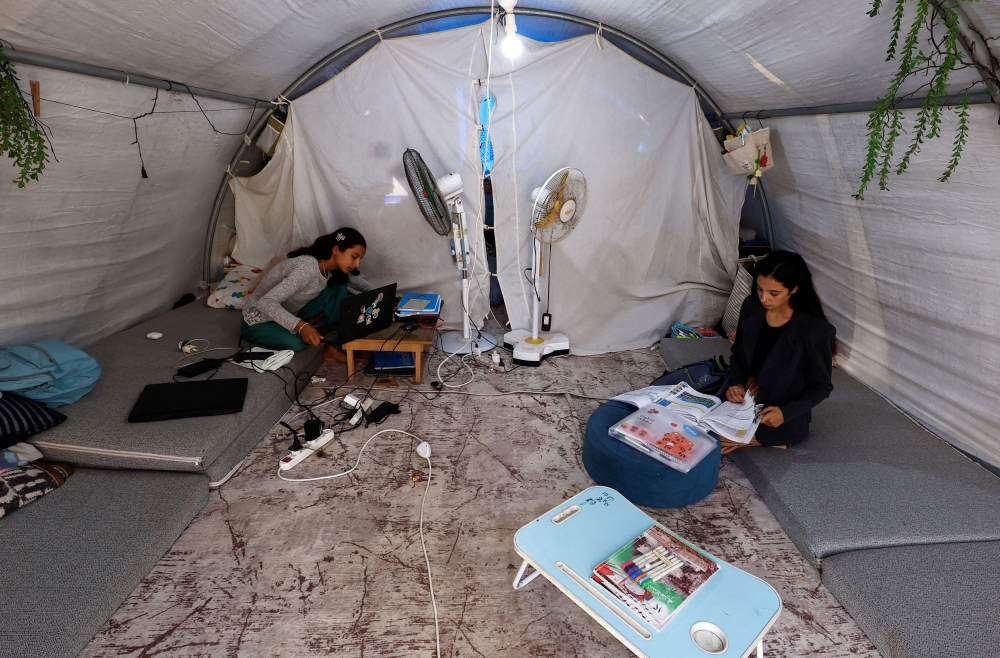AL-ZAWAYDA (Palestinian Territories), Oct 26 — His house in Gaza was destroyed by the war, but Hani Abu Omar still dreams of returning now that a ceasefire has taken hold.
However, like thousands of others, the 42-year-old Palestinian remains stuck in a tent with his family because it is too dangerous to go home.
Abu Omar’s house lies beyond the “Yellow Line” — the boundary behind which Israeli troops have pulled back under the October 10 truce.
The line stretches from north to south, across several towns and housing blocks. Yet residents told AFP they were unclear about its exact location, which the army has begun to mark out with yellow concrete blocks.
“Some young men from our family risked their lives, they went to inspect the destruction in our area and told us that my house was destroyed,” Abu Omar told AFP from the encampment in Al-Zawayda where he lives.
Still, he said, “I wish I could go back to Beit Lahia”, as “living here in the tents is unbearable”.
“The conditions aren’t suitable… and we’re suffering from skin diseases and lack of water.”
A Palestinian child looks on in front of a tent, amid a ceasefire between Israel and Hamas, in Gaza City October 20, 2025. — Reuters pic
Israeli forces’ withdrawal beyond the Yellow Line has left them in control of around half of Gaza, including the territory’s borders, but not its main cities.
Several incidents have been reported since the ceasefire began in which the military said its troops had fired at individuals who approached or crossed the line.
At Abu Omar’s white plastic tent — one of scores at the encampment in central Gaza — a few blankets were stretched out in front of the entrance to provide some semblance of privacy.
Residents prepared food in pots placed directly on the sand, where barefoot children sat.
Nearby, in a row of tents stretching for hundreds of metres, a woman baked bread in a makeshift oven made of cinder blocks.

A drone view shows tents of displaced Palestinians, amid a ceasefire between Israel and Hamas in Gaza, in Deir Al-Balah, in the central Gaza Strip, October 22, 2025. — Reuters pic
Overcrowded camps
Hundreds of thousands of Palestinians displaced by fighting and bombing have returned to northern Gaza since October 10, often struggling to find their homes amid the ruins left by the war triggered by Hamas’ unprecedented attack on Israel on October 7, 2023.
But elsewhere, thousands of others are unable to go back to their homes, with the Israeli army regularly calling on people not to approach troops deployed in the area.
Only 10 per cent of people displaced within the Gaza Strip “reside in collective centres, including UNRWA-designated emergency shelters”, said a statement Thursday by the UN humanitarian agency OCHA.
“The majority remain in overcrowded, makeshift sites, many of which were set up spontaneously in open or unsafe areas,” it added.
Gaza’s civil defence agency, a rescue force operating under Hamas authority, urged displaced people on Friday to secure their tents properly and to avoid taking refuge in buildings at risk of collapse.

Palestinian student Raghad Loai Mhanna, who passed her high school exams while living in a tent after being displaced during the war, sits inside her tent in Deir al-Balah, central Gaza Strip October 19, 2025. — Reuters pic
“Tents don’t protect anyone, they are useless. They don’t protect us from the cold or heat,” said displaced Palestinian Sanaa Jihad Abu Omar.
“Imagine one tent for eight people. Life here is extremely difficult.”
Following the ceasefire, more than one million hot meals a day are being distributed in the Palestinian territory, OCHA said.
In north Gaza, six UN-supported bakeries have resumed bread production, and over the last couple of days, around 600,000 diapers, 11,000 jerry cans, 5,800 household hygiene kits and 3,000 buckets were distributed to displaced people, it added.
“It’s true some goods have been brought in and some goods have even become cheaper. But still, we have no money to buy anything,” said Abu Omar.
“There’s no work and no income. How can we buy things?” — AFP








